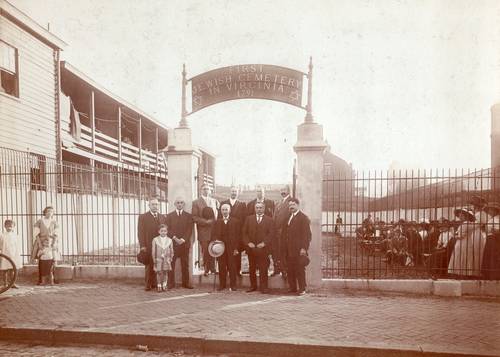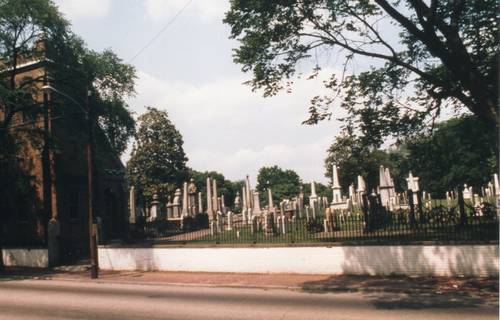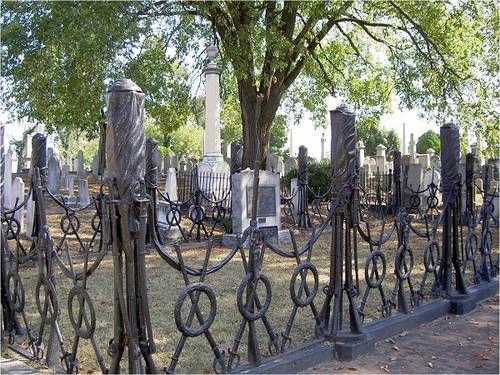Franklin Street Burying Ground
 The first Jewish cemetery in Virginia was the Franklin Street Burying Ground, at 21st and Franklin Streets in Richmond. It was established in 1791 by K.K. Beth Shalome, the first synagogue in Richmond and Virginia. It was quickly filled. The cemetery is now surrounded by an apartment complex, and only two graves in the right rear corner are visible. Records exist for some of the burials that took place here, but there is no complete list of burials in this cemetery.
The first Jewish cemetery in Virginia was the Franklin Street Burying Ground, at 21st and Franklin Streets in Richmond. It was established in 1791 by K.K. Beth Shalome, the first synagogue in Richmond and Virginia. It was quickly filled. The cemetery is now surrounded by an apartment complex, and only two graves in the right rear corner are visible. Records exist for some of the burials that took place here, but there is no complete list of burials in this cemetery.
Hebrew Cemetery
 In 1816, K.K. Beth Shalome purchased a much larger property, at 4th and Hospital Streets on Shockoe Hill, to be the site of their new burying ground, Hebrew Cemetery. Congregation Beth Ahabah was given burial rights, and the two congregations later created the Hebrew Cemetery Company to jointly administer the cemetery. The Hebrew Cemetery Company continues to manage both Hebrew Cemetery and the Franklin Street Burying Ground. Hebrew Cemetery was listed on the National Register of Historic Places and the Virginia Landmarks Register in 2006.
In 1816, K.K. Beth Shalome purchased a much larger property, at 4th and Hospital Streets on Shockoe Hill, to be the site of their new burying ground, Hebrew Cemetery. Congregation Beth Ahabah was given burial rights, and the two congregations later created the Hebrew Cemetery Company to jointly administer the cemetery. The Hebrew Cemetery Company continues to manage both Hebrew Cemetery and the Franklin Street Burying Ground. Hebrew Cemetery was listed on the National Register of Historic Places and the Virginia Landmarks Register in 2006.
Contact Beth Ahabah Museum & Archives for Cemetery tour information. Hebrew Cemetery is open to the public. A security guard also is present on the first and third Sundays of each month from 12 p.m. to 3 p.m.
Directions to the Hebrew Cemetery.
The first interment at Hebrew Cemetery was that of Benjamin Wolfe. Mr. Wolfe, a merchant and one of the founding fathers of K.K. Beth Shalome, was chairman of the committee formed in 1816 to acquire a new cemetery for the congregation. He also was a member of Richmond Common Hall (the town council), and this position allowed him to lobby for the new cemetery. After arrangements for the cemetery were completed, it is told that Mr. Wolfe laughingly remarked that the Congregation’s president should be the first person interred in the new grounds. The president responded with a biblical passage to the effect that he who dug a pit should be the first to fall into it. Ironically, Mr. Wolfe died in 1817 and was the first to be buried in the new cemetery. His gravestone reads that he was buried in 1818, so he may have first been interred in the Franklin Street Burying Ground and then reinterred in Hebrew Cemetery. The records are unclear.
Hebrew Cemetery is filled with a number of elaborate memorials to the deceased. Chest and table tombs, cradle graves and rustic tree monuments are found among the tall obelisks, broken columns and draped urns. Jewish symbols such as the shofar and the hands positioned for the priestly blessing of the Kohanim are found on the gravestones. There are also many funereal symbols shared with the larger community, such as the weeping willow tree, lambs, doves and flowers. Inscriptions on the gravestones often impart many details about the lives of the deceased.
The original acreage of Hebrew Cemetery has been expanded several times over the years. Another section, across the street, was established in 1911 and expanded in 1999.
Please help the Hebrew Cemetery Company maintain the historic cemeteries. Your gift will be greatly appreciated. CONTRIBUTE
Soldiers' Section
 Thirty Jewish Confederate soldiers are buried in a separate section of Hebrew Cemetery, having died in or near Richmond during the Civil War. One soldier is still unidentified. Most of the soldiers buried there were citizens of other Confederate states, dying too far away to be taken home for burial. The Hebrew Ladies’ Memorial Association cared for the graves, and was responsible for creating grave markers, holding yearly memorial services and erecting an ornamental iron fence to surround the section. In the 1950’s, the individual grave stones were replaced by a bronze plaque listing the soldiers’ names. It is believed the the Soldiers’ Section is the only Jewish military cemetery in the United States and one of the few outside of Israel.
Thirty Jewish Confederate soldiers are buried in a separate section of Hebrew Cemetery, having died in or near Richmond during the Civil War. One soldier is still unidentified. Most of the soldiers buried there were citizens of other Confederate states, dying too far away to be taken home for burial. The Hebrew Ladies’ Memorial Association cared for the graves, and was responsible for creating grave markers, holding yearly memorial services and erecting an ornamental iron fence to surround the section. In the 1950’s, the individual grave stones were replaced by a bronze plaque listing the soldiers’ names. It is believed the the Soldiers’ Section is the only Jewish military cemetery in the United States and one of the few outside of Israel.
In 1866 Mrs. Abraham (Rachel) Levy, corresponding secretary of the Hebrew Ladies’ Memorial Association, issued an appeal for funds to care for the graves of the soldiers. She wrote, in part, “In our own cemetery repose, alas!, the sacred remains of many a loved brother, son and husband, to whose relatives, in the far sunny South, it would be a solace to know that the pious duty of preserving from decay the last resting place of their lost ones, although denied to them to perform, is yet sacredly fulfilled by the members of the ‘Hebrew Ladies’ Memorial Association.'” Major William Barksdale Myers, a descendant of the colonial silversmith Myer Myers, designed an elaborate ornamental iron fence to surround the section. It depicts draped muskets, crossed swords and sabers, with a flat Confederate soldier’s cap adorning the top of the fence posts. These items were all emblems of the Confederate military. The fence was installed prior to May 20, 1868. Individual gravestones were initially installed, but their eventual decay required their removal and replacement with a bronze plaque listing the soldiers’ names, which is affixed to a large granite stone.
All but one of the soldiers in this plot is identified by name. Information about those buried varies, and may include their state of residence, military unit, and date and location of death. Several other Jewish Confederate soldiers from Virginia and beyond are buried in other locations in the cemetery.
In 1963 a correction was added to the bronze plaque regarding the name of one of the soldiers. Henry Gintzberger, a German immigrant, enlisted in the Salem Flying Artillery at the beginning of the Civil War and was killed at Cold Harbor, VA in 1864. His name was mistakenly reported to be “Gersberg” and he was buried in the Soldiers’ Section under that name. Richmond historian J. Ambler Johnston, whose father served with Gintzberger, correctly identified this long-dead soldier after more than 20 years of research. In a ceremony during the Civil War Centennial in 1965, Gintzberger’s name was added to the plaque. The soldier, who fought under Stonewall Jackson at Chancellorsville and was wounded at Gettysburg, now rests under his own name.





